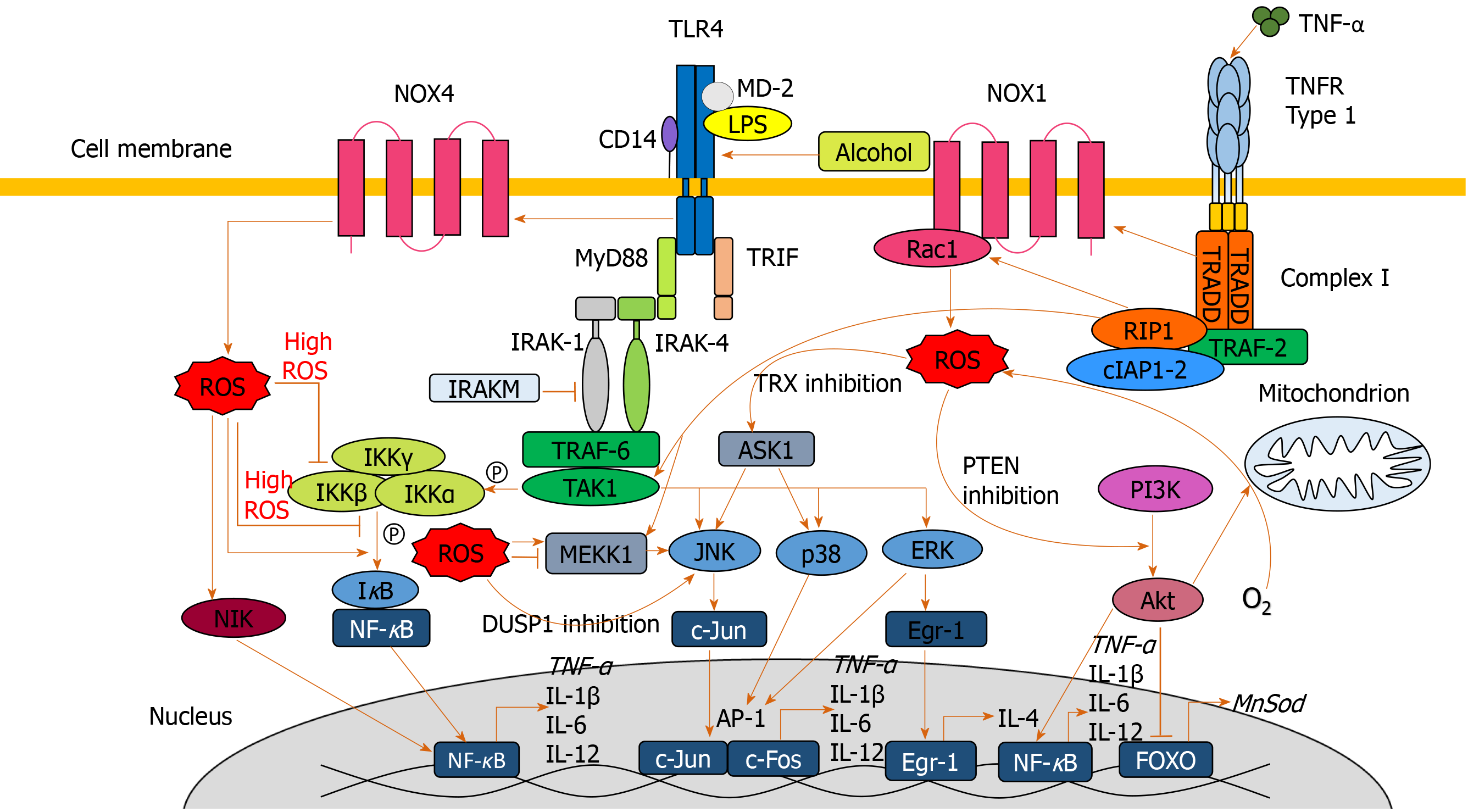Copyright
©The Author(s) 2020.
World J Hepatol. Jul 27, 2020; 12(7): 332-349
Published online Jul 27, 2020. doi: 10.4254/wjh.v12.i7.332
Published online Jul 27, 2020. doi: 10.4254/wjh.v12.i7.332
Figure 3 Signaling pathways involved in exacerbating oxidative damage and liver injury.
Lipopolysaccharide, alcohol and extracellular reactive oxygen species (ROS) are all capable of activating toll-like receptor 4 leading to myeloid differentiation primary response 88 (MyD88) activation. MyD88 association with interleukin-1 receptor-associated kinase 1-4 results in activation of the tumor necrosis factor receptor-associated factor 6/transforming growth factor beta-activated kinase 1 complex, which activates MAPKs c-Jun N-terminal kinase, p38 and extracellular signal-regulated protein kinase, facilitating transcription factors activator protein 1 and early growth response protein 1 to translocate to the nucleus and upregulate pro-inflammatory mediators. Tumor necrosis factor receptor-associated factor 6/transforming growth factor beta-activated kinase 1-mediated phosphorylation of the IKKα-β-γ complex leads to IκB phosphorylation and nuclear factor κB (NF-κB) translocation to the nucleus to upregulate pro-inflammatory cytokines. MyD88 signaling also activates NADPH oxidase 4 to produces ROS. ROS are also produced by the NADPH oxidase 1/ras-related C3 botulinum toxin substrate 1 complex which is activated upstream by tumour necrosis factor alpha interacting with tumour necrosis factor alpha receptor type 1, at the cell surface, which activates complex I. ROS upregulate NF-κB translocation to the nucleus through IκB phosphorylation, nuclear factor κB inducing kinase activation and indirect protein kinase B activation. At high concentrations, ROS inhibit NF-κB activation through inhibition of IκB phosphorylation and S-glutathionylation of IKKβ. ROS inhibit dual specificity protein phosphatase 1 and thioredoxin to further upregulate the c-Jun N-terminal kinase pathway. ROS inactivation of phosphatase and tensin homolog facilitates phosphoinositide 3-kinase to produce protein kinase B, which elevates ROS levels via increased oxygen consumption, and inactivates forkhead box protein O and downstream antioxidant expression. AKT: Protein kinase B; AP-1: Activator protein 1; ASK1: Apoptosis signal-regulating kinase 1; DUSP1: Dual specificity protein phosphatase 1; Egr-1: Early growth response protein 1; ERK: Extracellular signal-regulated protein kinase; FOXO: Forkhead box protein O; IAP: Inhibitor of apoptosis; IFN: Interferon; IL: Interleukin; IRAK: Interleukin-1 receptor-associated kinase 1; JNK: C-Jun N-terminal kinase; LPS: Lipopolysaccharide; MEKK1: Mitogen-activated protein kinase kinase kinase 1; MyD88: Myeloid differentiation primary response 88; NF-κB: Nuclear factor κB; NIK: Nuclear factor κB inducing kinase; NOX: NADPH oxidase; MnSOD: Manganese-dependent superoxide dismutase; PI3K: Phosphoinositide 3-kinase; PTEN: Phosphatase and tensin homolog; Rac1: Ras-related C3 botulinum toxin substrate 1; ROS: Reactive oxygen species; TAK1: Transforming growth factor beta-activated kinase 1; TLR4: Toll-like receptor 4; TNF-α: Tumour necrosis factor alpha; TNFR1: Tumour necrosis factor alpha receptor 1; TRADD: Tumour necrosis factor alpha receptor 1-associated death domain protein; TRAF: Tumor necrosis factor receptor-associated factor; TRIF: TIR-domain-containing adapter-inducing interferon-β; TRX: Thioredoxin; TXNIP: Thioredoxin-interacting protein.
- Citation: Tan HK, Yates E, Lilly K, Dhanda AD. Oxidative stress in alcohol-related liver disease. World J Hepatol 2020; 12(7): 332-349
- URL: https://www.wjgnet.com/1948-5182/full/v12/i7/332.htm
- DOI: https://dx.doi.org/10.4254/wjh.v12.i7.332









